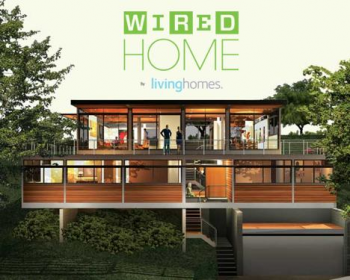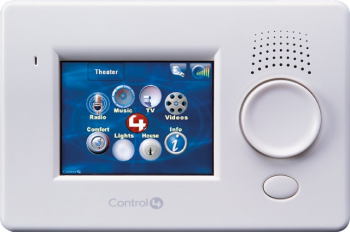Smart Living in the Wired Home
by: Daniel Chamberlain / USC

The housing bubble may be bursting, but you wouldn’t know it from the Wired Home. In case you weren’t glued to your browser watching its installation last week, the Wired Home is a residential tear-down in the Crestwood Hills neighborhood of Los Angeles, conceived as “a showcase of the best in sustainability, technology, and design.”[i] A project of the LivingHomes company, the house features pre-fab construction techniques, the greenest of green building features, and sleek, modernist design from Ray Kappe, a big-name architect and the founder of the Southern California Institute of Architecture. LivingHome’s partner is Wired Magazine, responsible for outfitting the home with a comprehensive, integrated, and enviable technological infrastructure, and, of course, lending the cachet and awareness that the Wired brand confers. Although its emphasis on high-profile design and technology has all the hallmarks of “the home of the future,” the partners insist that their project, which will be sold for four million dollars after a season of public tours, is a showcase of the best practices commercially available today. This innovative project provides insight into the spatial dynamics of media convergence, the ability of corporate and entrepreneurial branding to create a market niche, and tensions in what it means to think progressively about the built environment.

If this house were to be described in a single word, a good candidate would be convergence. Popular talk of media convergence tends to focus on the multifaceted capabilities of individual devices, but that perspective generally fails to account for the integration of such technologies with their environments. Although there are a few stand-alone technological flourishes in the Wired Home, like a biometric iris reader governing entry to the front door, the emphasis is on getting diverse technologies to work together. Present in nearly every room is a series of screens and interfaces. At the heart of the system is a Moxi multi-room Digital Media Recorder, a TiVo competitor capable of delivering photos, video, audio, games, and data to rooms throughout the house. But this media center is merely a component of a larger home automation system, which will connect the entertainment services, several touch-screen computers, temperature control, the lighting system, and home security, all controllable through hand-held touch screen remotes. Like the customized systems used in the much lauded and critiqued Gates home, off-the-shelf commercial solutions are brought together seamlessly in the Wired Home to make it a paragon of the convergent residence.[ii] Millions of home theater owners, home network builders, and early adopting technology users already have elements of these systems in their homes, but rarely do they have everything working in harmony.
As media and home automation technologies converge and extend across the space of the home, it is clear that convergence is simply another word for control, bringing with it all of the promise and peril that goes along with living a networked life. While television scholars have long appreciated the relationship between television sets, residential architecture and design, and daily patterns of domestic circulation, this understanding needs to be updated to consider the multiple networks in which contemporary screens are situated and the way corresponding spatial arrangements affect the uses and practices of domestic technologies. The media spaces created by the integration of entertainment media technologies with home automation systems and multiple external communications networks are multi-layered, unevenly distributed within homes and across neighborhoods, and determined by an array of forces, including municipal arrangements, corporate options, geographic limitations, cultural preferences, individual finances, and technological affinities.

While the integration of media and home automation technologies makes the Wired Home an interesting technological case study, it is also part of a conspicuous effort to link Wired’s traditional emphasis on technology with more contemporary markers of “smart living.” The ideological banner waved most enthusiastically by the project’s creators is that of sustainability — the previous house was deconstructed (rather than demolished) and 75% of that material is to be reused, the home is designed to earn a Gold LEED certification, efficient lighting, plumbing, and services will be used throughout, and funds raised through special events and tours will be donated to green organizations. While these are all positive and overdue steps for the housing construction industry, the no-stone unturned quality of their incorporation in LivingHomes’ projects seems designed not only to promote green living as an ethic but also to create green living as a lifestyle category; green is not simply something you do, but someone you are. But smart living doesn’t stop there. As constructed by the Wired Home, smart living means marrying green living with the ability to appreciate the refined simplicity of modern architecture, the benefits of automated technology, and the value of design. To make sure that the target market understands the parameters of smart living, the Wired Home has partnered with a range of signifying sponsors, featuring the latest no-emission vehicles from BMW, computers from HP, and even design elements for a kid’s room from Cookie, the magazine for children of distinction. Just as Wired and LivingHomes would have it, this is emphatically not the home everyone will be living in ten years from now, but rather the home that a certain demographic, a niche that is being targeted even as it is being constructed, aspires to live in right now. Although the elements of the house can be appreciated individually and as a whole, a primary function of the Wired House is clearly to commodify sustainability, technology, and design, and to create a profitable market niche out of those select individuals who can appreciate this mode of smart living.

Ultimately, this project is fraught with paradoxes. It is a showcase home, but its technologies and design are out of reach for the vast majority of homeowners. It will be one of the greenest homes ever built, but its construction involved tearing down an existing structure rather than adapting it. The suite of entertainment and information technologies in the home will offer its occupants unprecedented control over their environment, yet in the process will subject them to regimes of surveillance. The project’s governing principles of sustainability and prefabrication represent a progressive approach to the built environment, but its commitment to technology and architecturally-significant design — not to mention its 4,000 square foot layout and $4 million price tag — belie broader progressive goals of providing quality affordable housing to a broader public. This particular tension, between principles of progressive design and progressive urban planning, is perhaps the most troubling and familiar. Radical ideas in residential construction, from new urbanist regional plans to stylish pre-fab construction to green features, tend to exist as either renderings or high-end homes, as the capital necessary for their construction prefers the profit margins offered in upscale markets to those offered in affordable housing. While the Wired Home can be praised for emphasizing innovative design and sustainable building, it must also be recognized that the Wired Home is an exclusive demonstration of principles that will at best trickle down into high-end home building. There should be little doubt that this showcase will offer a wealth of lessons regarding the integration of sustainable building and home technologies, but we might ask whether this will simply serve as data for high-end home marketers or whether it might provide extensible insights that might address broader housing problems.
Notes
[i] The official press release for the project can be downloaded at http://www.epicurious.com/cs/wiredhome_text_release
A floorplan can be found at
http://www.wired.com/promo/wiredlivinghome/pdf/wh07_floorplan.pdf
[ii] Lynn Spigel provides a critique of the Gates House, and future homes in general, in the essay “Yesterday’s Future, Tomorrow’s Home” in her book Welcome to the Dreamhouse: Popular Media and Postwar Suburbs; Fiona Allon builds on Spigel’s critique in her essay “An Ontology of Everyday Control” in the volume MediaSpace: Place, Scale and Culture in a Media Age.
Image Credits
2. The Control4 Wall Mount Touch Screen
Please feel free to comment.
Argh. I’m both fascinated and profoundly disturbed when I take the time to consider technology in the frame of concepts and projects such as these. I understand and appreciate media and technology models that consider early adopters and subsequent diffusion of technologies a necessary pathway for innovation. BUT I cannot help but question the necessity of much of human innovation when so much of the world lacks the basics in human essentials.
Especially when Chamberlain astutely notes “the Wired Home is an exclusive demonstration of principles that will at best trickle down into high-end home building” I have to ask: so what’s in it for me much less anyone else in lower economic strata? If the answer is “entertainment,” I’m inclined to believe that as a species we can and should do better with the resources we have left in the world. Don’t get me wrong. I’m tickled pink the house is green, but just as the current global summits on greenhouse gasses should tell us, in my opinion, until living “green” is a viable day-to-day option for everyone in developed, underdeveloped and developing cultures, the Wired Home is not much more than a window into a new form of liberal privileged guilt (or if you prefer “ambivalence”) — a way for “the haves” to play with progress while not actually have to reduce or even question their comfort, in a world filled with people who may not even have a floor to sleep on much less a roof over their heads.
Terrific piece. I wonder if we should be casting this iteration of the smart home as a kind of mythical space — something generated by a coalescing of various discourses on domestic life, the environment, and the real estate business — all of which circulate in and help create a culture deeply wedded to notions of futurity. It’s not as if the Wired home isn’t rooted in reality — you can tour it, after all — but to the extent that it can be experienced as a space for living is like saying one should relocate to Cinderella’s castle. (All jokes about Heritage USA aside.) Insofar as environmental goals and domestic technologies can overlap, it seems that one truly important avenue for scholarly intervention are the issues of scale and feasibility. I can’t help but think that these often seem to be underdeveloped veins of criticism in our corner of academe re: the promise of technology. It’s just as myopic to champion them without thinking through issues of access as it is to dismiss them as wholly impossible…..
Pingback: Make Room for Alexa Germaine Halegoua / University of Kansas – Flow